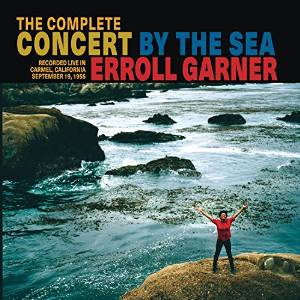 • My theater-related travel and the resulting deadlines haven’t left me with much spare time of late, but I’ve still managed in the past couple of weeks to consume and enjoy an album and two autobiographies.
• My theater-related travel and the resulting deadlines haven’t left me with much spare time of late, but I’ve still managed in the past couple of weeks to consume and enjoy an album and two autobiographies.
The album is Erroll Garner’s The Complete Concert by the Sea, a newly released three-CD set about which vast clouds of enthusiastic prose, none of it even slightly overstated, have already been generated, not just in the jazz press but in such mainstream publications as the New York Times and my own Wall Street Journal.
In case you haven’t heard, The Complete Concert by the Sea is a new and expanded reissue of the much-loved live album in which Garner and his hard-working trio were caught on the fly in 1955. Not only has it been carefully remastered—the mono sound was mediocre—but this new “reissue” contains twice as much music as the original LP, all of it thrilling.
Longtime readers of this blog won’t need reminding that I’m a huge Garner fan. As I wrote back in 2006:
One of Garner’s albums was called The Most Happy Piano, and that sums him up very nicely. As Joseph Epstein wrote of H.L. Mencken, “He achieves his effect through the magical transfer of joie de vivre.” You simply cannot listen to his best recordings without breaking out in an ear-to-ear grin.
That’s especially true of Concert by the Sea, in which Garner’s one-man-band piano style (big-band riffs in the right hand, guitar-like four-to-a-bar strumming in the left) is heard at its irresistibly infectious best. As the old bluesman said, if you don’t like this album, you don’t like ham and cheese.
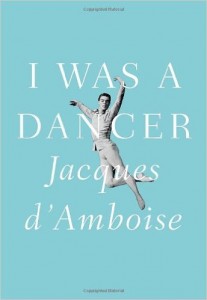 • I quit keeping up with new books about dance when I stopped going to dance performances a decade ago. As a result, I didn’t even realize that Jacques d’Amboise, one of the outstanding American ballet dancers of the twentieth century, had published an autobiography in 2011. When I saw I Was a Dancer in a Chicago bookstore two weeks ago, I decided that it might make for good airport reading, and I gulped the whole of it down last Thursday en route from Chicago to Connecticut. It turned out to be a delightful piece of work—naïve, unselfconscious, wholly engaging—that I very much wish had been published while I was still at work on my own brief life of George Balanchine, d’Amboise’s teacher and mentor.
• I quit keeping up with new books about dance when I stopped going to dance performances a decade ago. As a result, I didn’t even realize that Jacques d’Amboise, one of the outstanding American ballet dancers of the twentieth century, had published an autobiography in 2011. When I saw I Was a Dancer in a Chicago bookstore two weeks ago, I decided that it might make for good airport reading, and I gulped the whole of it down last Thursday en route from Chicago to Connecticut. It turned out to be a delightful piece of work—naïve, unselfconscious, wholly engaging—that I very much wish had been published while I was still at work on my own brief life of George Balanchine, d’Amboise’s teacher and mentor.
To be sure, d’Amboise’s up-from-the-working-class tale of personal transformation is fascinating in its own right, but I Was a Dancer is most interesting of all as an up-close chronicle of the early years of New York City Ballet. Take, for instance, this comparison of Balanchine and Jerome Robbins:
Robbins took what you did naturally, enhanced, packaged, and presented it—he helped you become more of what you already were. Balanchine took the music, developed his own ideas of movement, and challenged you to become more than you thought you could be. With Robbins, you were amplified; with Balanchine, you were transformed.
Bull’s-eye.
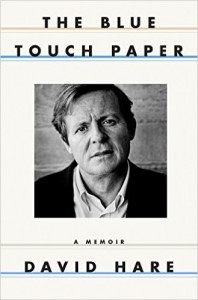 • Even more engrossing, at least to me, is The Blue Touch Paper, David Hare’s soon-to-be-published memoir, which comes out next month and whose bound galleys I finished reading last night.
• Even more engrossing, at least to me, is The Blue Touch Paper, David Hare’s soon-to-be-published memoir, which comes out next month and whose bound galleys I finished reading last night.
Hare is one of the few political playwrights whose best work I find consistently compelling, and The Blue Touch Paper explains why in this laser-like passage:
As my work reached a larger public, I would grow used to the pressures for censorship, offered for the most exemplary reasons. When people tell you they value political art, what they often mean is that they enjoy political propaganda which corroborates what they already think. All kinds of groups, including socialists and feminists, would ask me to reconfigure work in order to show what ought to happen rather than what does. I grew used to having to argue to the literal-minded that drama is not and cannot be a cartoon form of exhortation. It is about people, it is not about types.
The whole book is like that, sharp and unsparingly perceptive, not least about the author himself. On first reading I incline to rank it alongside Moss Hart’s Act One as one of the finest autobiographies ever written by a playwright. We’ll see whether time leads me to modify that snap judgment, but if you’re interested in postwar British theater, I can’t recommend it too strongly.
* * *
Three excerpts from George Balanchine’s Apollo, danced by Jacques d’Amboise as Apollo, Melissa Hayden as Terpsichore, Jillana as Calliope, and Patricia Neary as Polyhymnia. The score is by Igor Stravinsky. This performance was originally telecast in 1963 on NBC’s Bell Telephone Hour:



 The answer is as direct as the play itself: “The Rainmaker” tells you what you want to hear about human nature, and does so without once putting a dramatic foot wrong. Cast it well and stage it efficiently and the results will disarm all but the most cinder-hearted of cynics—and American Blues Theater has done it right as…well, rain. Not only are ABT’s seven actors beautifully suited to their roles, but Sarah Ross’ triple-interior set makes how’d-she-do-that use of every square inch of the 90-seat theater’s stage….
The answer is as direct as the play itself: “The Rainmaker” tells you what you want to hear about human nature, and does so without once putting a dramatic foot wrong. Cast it well and stage it efficiently and the results will disarm all but the most cinder-hearted of cynics—and American Blues Theater has done it right as…well, rain. Not only are ABT’s seven actors beautifully suited to their roles, but Sarah Ross’ triple-interior set makes how’d-she-do-that use of every square inch of the 90-seat theater’s stage….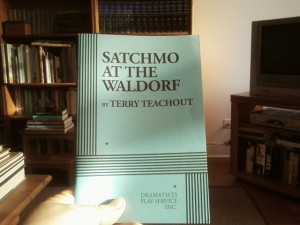 I arrived at my New York apartment last night after a longish stretch of time on the road and found a pile of unopened mail on the dining-room table. Most of it was instantaneously disposable—catalogues, uninteresting press releases, unwanted review copies—but no sooner did I see an inch-thick package from my theatrical agent than I pushed everything else aside and tore it open. It contained, as I expected, ten finished copies of the newly released acting edition of Satchmo at the Waldorf, my first play, forwarded to me from the publisher, the illustrous
I arrived at my New York apartment last night after a longish stretch of time on the road and found a pile of unopened mail on the dining-room table. Most of it was instantaneously disposable—catalogues, uninteresting press releases, unwanted review copies—but no sooner did I see an inch-thick package from my theatrical agent than I pushed everything else aside and tore it open. It contained, as I expected, ten finished copies of the newly released acting edition of Satchmo at the Waldorf, my first play, forwarded to me from the publisher, the illustrous 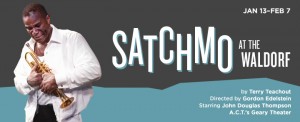 What it reveals, to be sure, is significant enough. In addition to DPS, everyone mentioned in those three paragraphs—every person and every institution—dared to take a costly chance on an untested playwright whose “credentials” were dubious in the extreme. A new play by a drama critic? Who was I trying to kid? But I was serious, and so were they…and now I hold the proof in my hands. Not only has Satchmo at the Waldorf been published, but it’s been staged in Orlando, Lenox, New Haven, Philadelphia, New York, and Los Angeles, with more stagings set for this season in
What it reveals, to be sure, is significant enough. In addition to DPS, everyone mentioned in those three paragraphs—every person and every institution—dared to take a costly chance on an untested playwright whose “credentials” were dubious in the extreme. A new play by a drama critic? Who was I trying to kid? But I was serious, and so were they…and now I hold the proof in my hands. Not only has Satchmo at the Waldorf been published, but it’s been staged in Orlando, Lenox, New Haven, Philadelphia, New York, and Los Angeles, with more stagings set for this season in 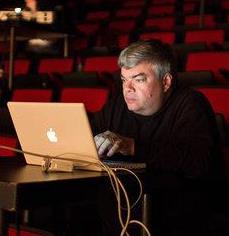 So how do I feel today? Grateful without limit—and ready to start kicking the can down the road again.
So how do I feel today? Grateful without limit—and ready to start kicking the can down the road again.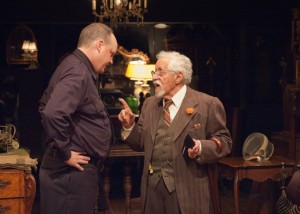 IN CHICAGO:
IN CHICAGO: